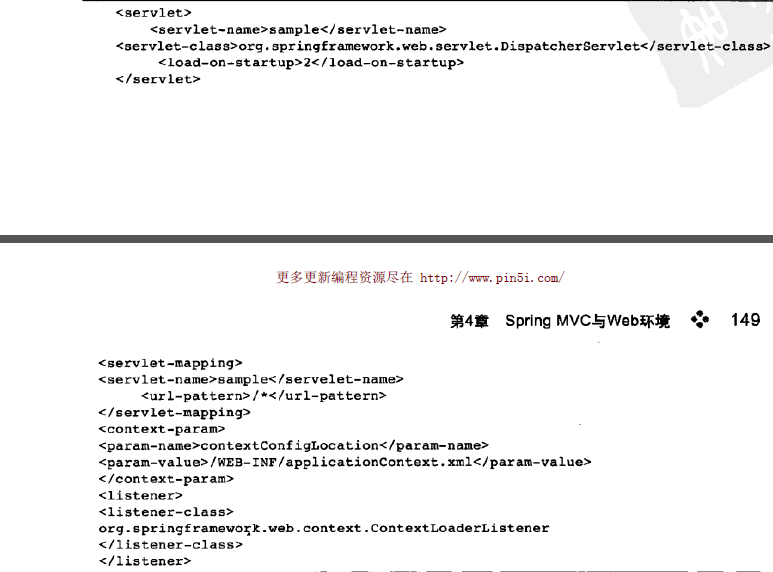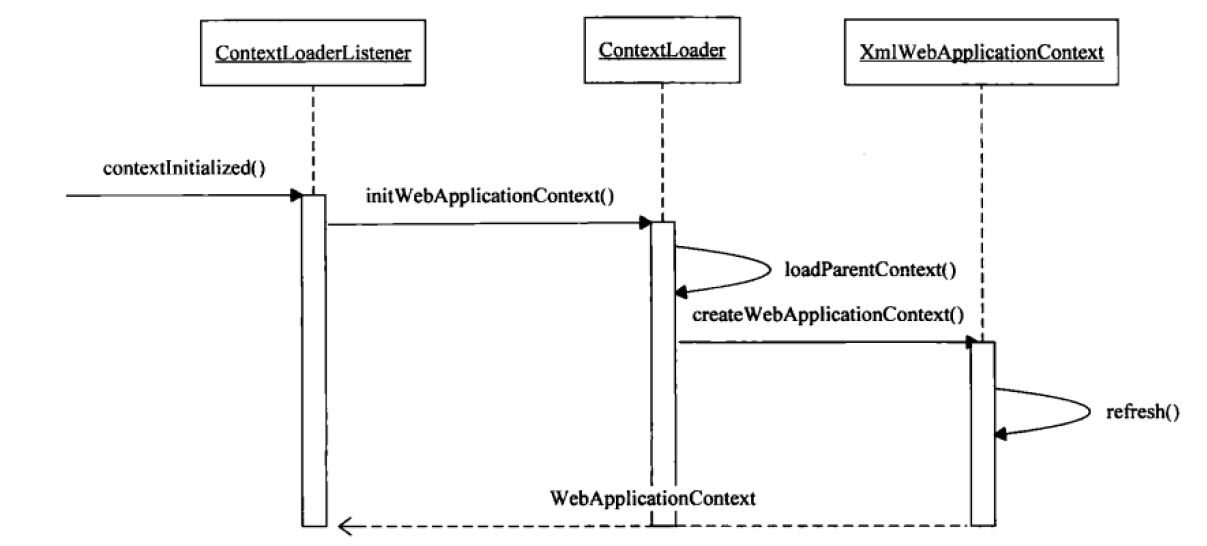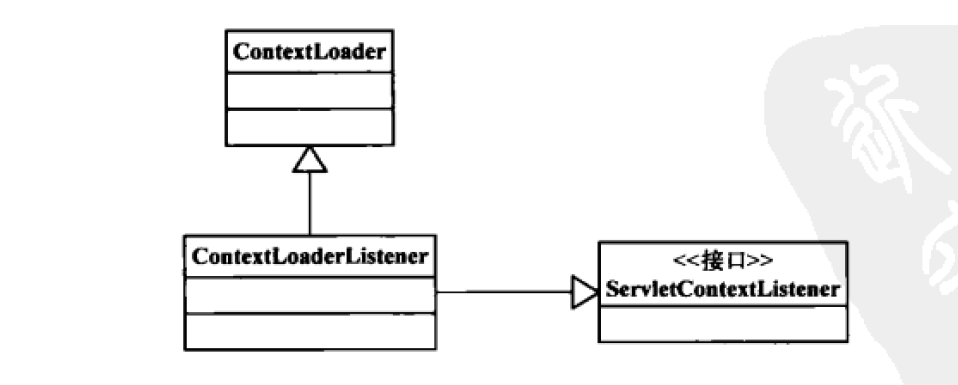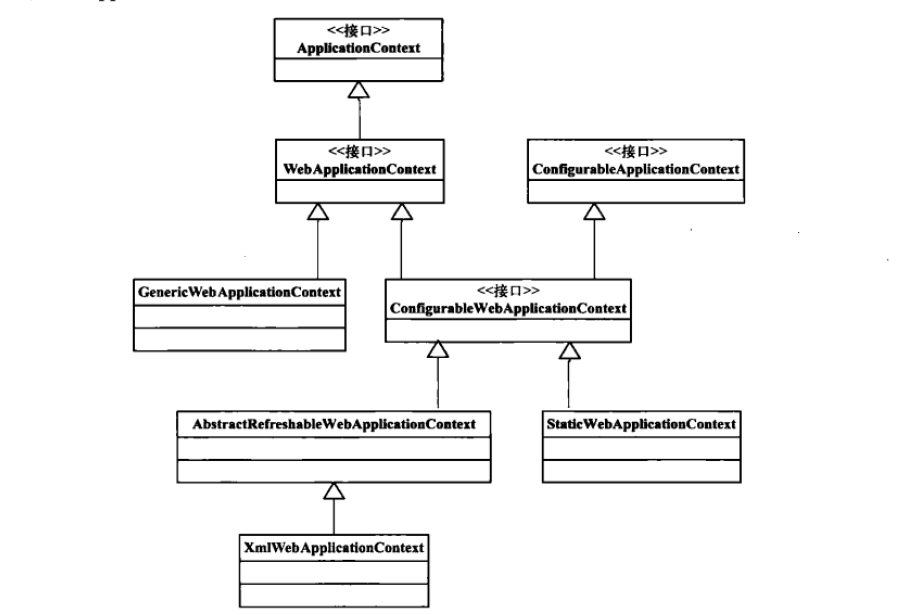7.1Tomcat的web.XML对springMVC 的描述:
dispatcherServlet定义了对应的URL的映射,context-param制定了bean的定义文件的路径,contextLoaderListener作为简历IOC容器的入口,加载IOC容器到servletContext中,即上下文。
7.2上下文在?WEB容器中的启动
在WEB容器中启动spring应用的过程:
ContextLoaderListener是一个监听器应为实现了servletAPI的ServletContextListener,就有了contextInitialized,contextDestroyed,而IOC容器的载入过程是由ContextLoaderListener的基类ContextLoader完成的:
他们关系:
7.3WEB容器中的上下文设置
WebApplicationContext的上下文设置:
在这个体系中XMLWebAppliocationContext初始化过程中建立了IOC容器:
public class XmlWebApplicationContext extends AbstractRefreshableWebApplicationContext {
/** Default config location for the root context */
//bean定义文件定义为常量
public static final String DEFAULT_CONFIG_LOCATION = "/WEB-INF/applicationContext.xml";
/** Default prefix for building a config location for a namespace */
//配置文件父级路径
public static final String DEFAULT_CONFIG_LOCATION_PREFIX = "/WEB-INF/";
/** Default suffix for building a config location for a namespace */
//配置文件默认的后缀名是.XML
public static final String DEFAULT_CONFIG_LOCATION_SUFFIX = ".xml";
/**
* Loads the bean definitions via an XmlBeanDefinitionReader.
* @see org.springframework.beans.factory.xml.XmlBeanDefinitionReader
* @see #initBeanDefinitionReader
* @see #loadBeanDefinitions
*/
@Override
protected void loadBeanDefinitions(DefaultListableBeanFactory beanFactory) throws BeansException, IOException {
// Create a new XmlBeanDefinitionReader for the given BeanFactory.
//使用XmlBeanDefinitionReader进行BeanDefination的解析
XmlBeanDefinitionReader beanDefinitionReader = new XmlBeanDefinitionReader(beanFactory);
// Configure the bean definition reader with this context's
// resource loading environment.
beanDefinitionReader.setEnvironment(this.getEnvironment());
//因为XmlWebApplicationContext 是defaultResourceLoader的子类,因此传入this
beanDefinitionReader.setResourceLoader(this);
beanDefinitionReader.setEntityResolver(new ResourceEntityResolver(this));
// Allow a subclass to provide custom initialization of the reader,
// then proceed with actually loading the bean definitions.
//允许子类为reader配置自定的初始化过程
initBeanDefinitionReader(beanDefinitionReader);
//使用定义好的XmlBeanDefinitionReader载入BeanDefinition
loadBeanDefinitions(beanDefinitionReader);
}loadBeanDefinitions方法代码:
//有多个beanDefination定义要逐个载入
protected void loadBeanDefinitions(XmlBeanDefinitionReader reader) throws IOException {
String[] configLocations = getConfigLocations();
if (configLocations != null) {
for (String configLocation : configLocations) {
reader.loadBeanDefinitions(configLocation);
}
}
}得到Resource的路径默认是“/WEB-INF/applicationContext.xml”
protected String[] getDefaultConfigLocations() {
if (getNamespace() != null) {
return new String[] {DEFAULT_CONFIG_LOCATION_PREFIX + getNamespace() + DEFAULT_CONFIG_LOCATION_SUFFIX};
}
else {
return new String[] {DEFAULT_CONFIG_LOCATION};
}
}ContextLoaderListener的contextInitialized初始化:
public void contextInitialized(ServletContextEvent event) {
this.contextLoader = createContextLoader();
if (this.contextLoader == null) {
this.contextLoader = this;
}
this.contextLoader.initWebApplicationContext(event.getServletContext());
}我们再到他的基类ContextLoader中WEB容器的加载过程:
public WebApplicationContext initWebApplicationContext(ServletContext servletContext) {
//如果已经加载会抛出异常
if (servletContext.getAttribute(WebApplicationContext.ROOT_WEB_APPLICATION_CONTEXT_ATTRIBUTE) != null) {
throw new IllegalStateException(
"Cannot initialize context because there is already a root application context present - " +
"check whether you have multiple ContextLoader* definitions in your web.xml!");
}
Log logger = LogFactory.getLog(ContextLoader.class);
servletContext.log("Initializing Spring root WebApplicationContext");
if (logger.isInfoEnabled()) {
logger.info("Root WebApplicationContext: initialization started");
}
long startTime = System.currentTimeMillis();
try {
// Store context in local instance variable, to guarantee that
// it is available on ServletContext shutdown.
if (this.context == null) {
// 创建上下文
this.context = createWebApplicationContext(servletContext);
}
if (this.context instanceof ConfigurableWebApplicationContext) {
configureAndRefreshWebApplicationContext((ConfigurableWebApplicationContext)this.context, servletContext);
}
//将创建好的上下文放在servletContext中
servletContext.setAttribute(WebApplicationContext.ROOT_WEB_APPLICATION_CONTEXT_ATTRIBUTE, this.context);
ClassLoader ccl = Thread.currentThread().getContextClassLoader();
if (ccl == ContextLoader.class.getClassLoader()) {
currentContext = this.context;
}
else if (ccl != null) {
currentContextPerThread.put(ccl, this.context);
}
if (logger.isDebugEnabled()) {
logger.debug("Published root WebApplicationContext as ServletContext attribute with name [" +
WebApplicationContext.ROOT_WEB_APPLICATION_CONTEXT_ATTRIBUTE + "]");
}
if (logger.isInfoEnabled()) {
long elapsedTime = System.currentTimeMillis() - startTime;
logger.info("Root WebApplicationContext: initialization completed in " + elapsedTime + " ms");
}
return this.context;
}
catch (RuntimeException ex) {
logger.error("Context initialization failed", ex);
servletContext.setAttribute(WebApplicationContext.ROOT_WEB_APPLICATION_CONTEXT_ATTRIBUTE, ex);
throw ex;
}
catch (Error err) {
logger.error("Context initialization failed", err);
servletContext.setAttribute(WebApplicationContext.ROOT_WEB_APPLICATION_CONTEXT_ATTRIBUTE, err);
throw err;
}
}createWebApplicationContext(servletContext)即实例化上下文:
protected WebApplicationContext createWebApplicationContext(ServletContext sc) {
//探查将那个类在WEB容器中作为IOC容器
Class<?> contextClass = determineContextClass(sc);
if (!ConfigurableWebApplicationContext.class.isAssignableFrom(contextClass)) {
throw new ApplicationContextException("Custom context class [" + contextClass.getName() +
"] is not of type [" + ConfigurableWebApplicationContext.class.getName() + "]");
}
//实例化IOC 容器
ConfigurableWebApplicationContext wac =
(ConfigurableWebApplicationContext) BeanUtils.instantiateClass(contextClass);
return wac;
}默认是WebApplicationContext作为容器:
protected Class<?> determineContextClass(ServletContext servletContext) {
//CONTEXT_CLASS_PARAM是WEB.xml的配置参数
String contextClassName = servletContext.getInitParameter(CONTEXT_CLASS_PARAM);
if (contextClassName != null) {
try {
return ClassUtils.forName(contextClassName, ClassUtils.getDefaultClassLoader());
}
catch (ClassNotFoundException ex) {
throw new ApplicationContextException(
"Failed to load custom context class [" + contextClassName + "]", ex);
}
}
else {
//默认是WebApplicationContext
contextClassName = defaultStrategies.getProperty(WebApplicationContext.class.getName());
try {
return ClassUtils.forName(contextClassName, ContextLoader.class.getClassLoader());
}
catch (ClassNotFoundException ex) {
throw new ApplicationContextException(
"Failed to load default context class [" + contextClassName + "]", ex);
}
}
}configureAndRefreshWebApplicationContext方法接着设置IOC的各个参数,随后通过refresh启动容器的初始化,refresh参考前边的 FileSystemXmlApplicationContext的IOC的初始化过程。
protected void configureAndRefreshWebApplicationContext(ConfigurableWebApplicationContext wac, ServletContext sc) {
if (ObjectUtils.identityToString(wac).equals(wac.getId())) {
// The application context id is still set to its original default value
// -> assign a more useful id based on available information
String idParam = sc.getInitParameter(CONTEXT_ID_PARAM);
if (idParam != null) {
wac.setId(idParam);
}
else {
// Generate default id...
if (sc.getMajorVersion() == 2 && sc.getMinorVersion() < 5) {
// Servlet <= 2.4: resort to name specified in web.xml, if any.
wac.setId(ConfigurableWebApplicationContext.APPLICATION_CONTEXT_ID_PREFIX +
ObjectUtils.getDisplayString(sc.getServletContextName()));
}
else {
wac.setId(ConfigurableWebApplicationContext.APPLICATION_CONTEXT_ID_PREFIX +
ObjectUtils.getDisplayString(sc.getContextPath()));
}
}
}
// Determine parent for root web application context, if any.
ApplicationContext parent = loadParentContext(sc);
//设置双亲上下文
wac.setParent(parent);
//设置servletcontext以及配置文件的位置参数
wac.setServletContext(sc);
String initParameter = sc.getInitParameter(CONFIG_LOCATION_PARAM);
if (initParameter != null) {
wac.setConfigLocation(initParameter);
}
customizeContext(sc, wac);
//调用refresh初始化IOC容器
wac.refresh();
}
























 944
944











 被折叠的 条评论
为什么被折叠?
被折叠的 条评论
为什么被折叠?








